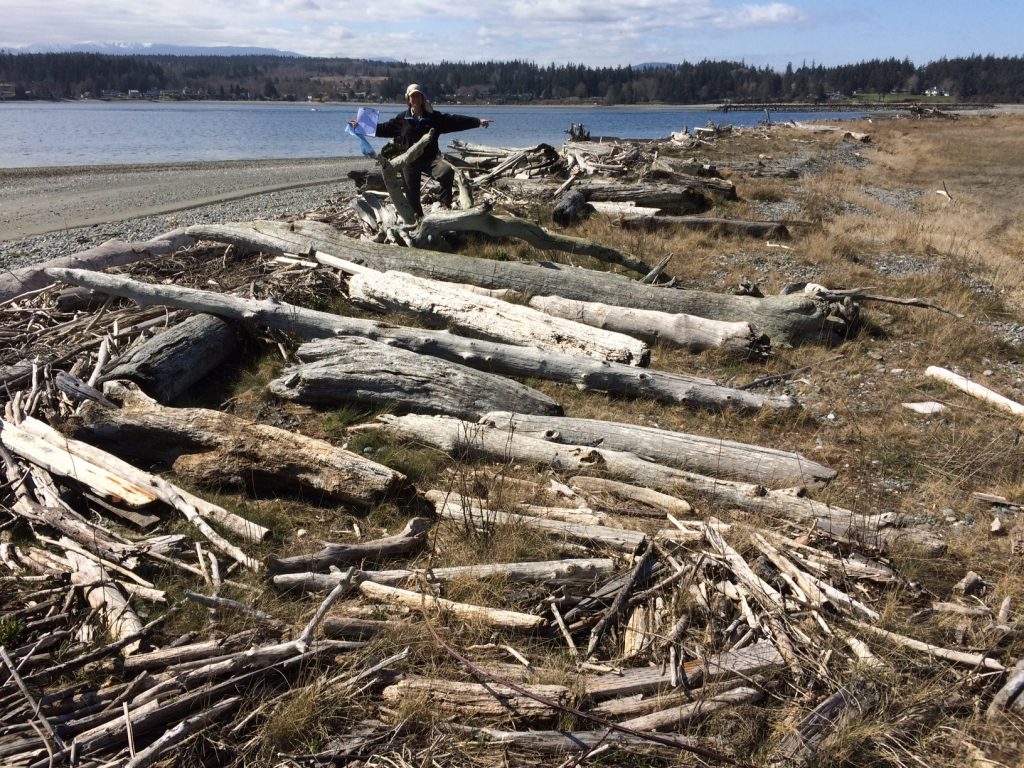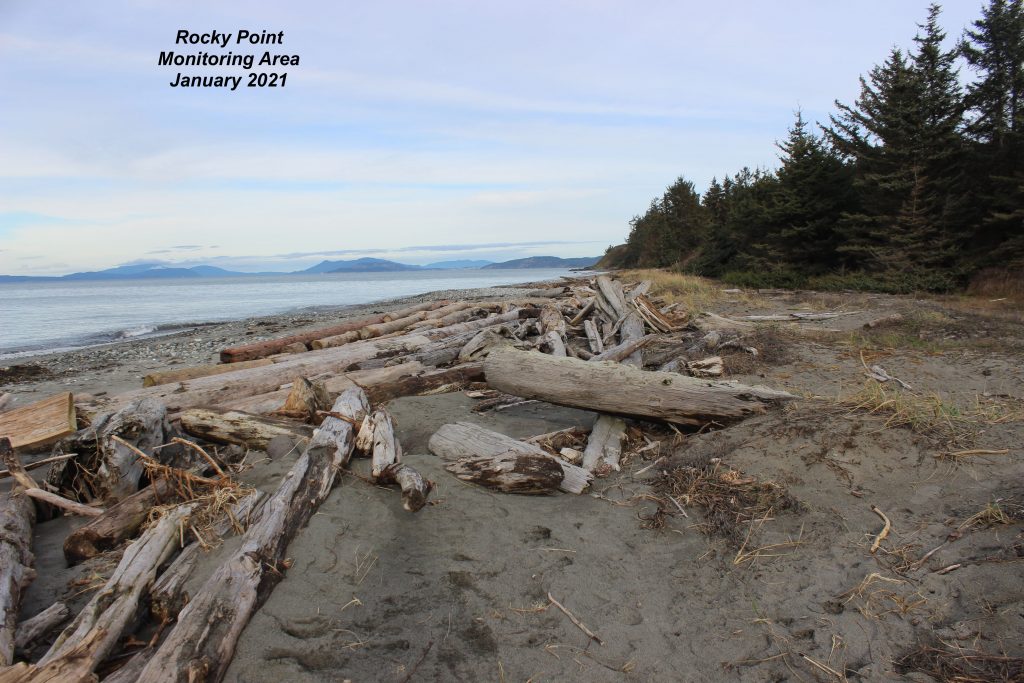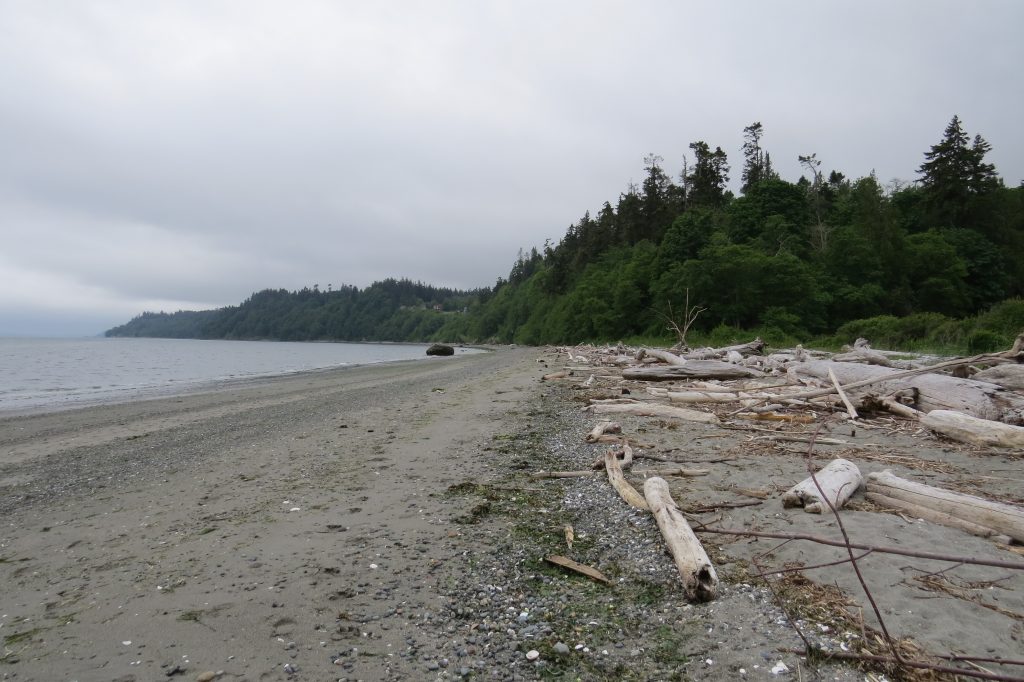COASST’s wood zone describes the high beach where driftwood has been deposited, above the reach of most high tides.
In short, it’s the area filled with semi-permanent downed trees and chopped logs.
Driftwood deposits can vary widely along the coast. Beaches in the Pacific Northwest – due to their proximity to forests and logging activity – often have larger wood zones than beaches further south, while winter storms anywhere along the coastline can cause wood to be cleared and/or deposited in mass.
Photo by Sarah Grimes Seaside N
When driftwood persists on a beach, exposure to the sun and air can cause the wood to become smooth, lose bark and branches, and leach color creating the classic, beachy-white driftwood appearance. In the photo of Stonefield Beach below, driftwood has been pushed against the sea cliffs above the regular high tide line, where it has persisted long enough to be bleached white.

When wood sticks around for that long on the beach, we know that other things might stay there too. Birds and debris on COASST surveys can both be found up in the ‘sticky’ wood zone. If they are found there once, they may be refound on many subsequent surveys if there are no storms or king tides.

A small wood zone like the one on Buggy Beach above can be searched by walking along the outer edge, or stepping carefully between the logs. However, those logs look like they might be damp and slippery! If the wood zone was much wider, a COASST surveyor might decide it’s unsafe to walk that area for either pacing or surveying. In that case it’s best just to mark that zone UM for ‘UnMeasured’ on this survey. Safety always comes first!
Tough calls: wood vs vegetation
When comparing two zones, predominance and persistence are the rules of the game. If the area is covered 50% or more by wood with only a few scattered plants, then we can use the rule of predominance to determine ‘that’s a wood zone‘. If there are a few pieces of wood in an area covered 50% or more by vegetation, that’s the vegetation zone.
That’s easy to say, but can be hard in practice! In the below survey of Lagoon Beach South, it was difficult to draw the line between those two zones. Our surveyor is standing in the middle of driftwood, but where does that wood zone end and the vegetation begin?

We can look first to percent coverage – when it becomes about 50/50 vegetation and wood, we lean towards vegetation because it is the more permanent feature. It can also help to look up and down the length of the beach to determine the zone’s extent along the entire beach area. One ‘rogue’ log does not a zone make!
Here’s how we might have paced Lagoon Beach South on this day:

In comparison, this survey of Rocky Point had a much more definite line between the wood and vegetation zones. The slight change in elevation at the top of the beach helped to trap the wood below the saltwater-free line where grass began to grow.

The next photo from Point No Point shows a great example of a wrack line that comes right up to the wood zone. The driftwood covers the entire ‘high beach’ area, and the vegetation begins in a clear line at the very top.

If we ‘zoom in’ on this wood zone we can see that there is more than natural driftwood here. There are several pieces of lumber (or ‘dimensionalized wood’) as well as a beam with metal bolts driven into it. That’s debris that large debris surveyors would count only on their quarterly ‘lumber’ survey.

Coming soon: a blog post describing the major differences between driftwood and lumber, as well as an overview of the quarterly lumber survey for Large Debris COASST surveyors.
What does the driftwood do for the environment?
Driftwood doesn’t just provide a ‘sticky’ spot for debris and birds on a beach – when it washes out it can also be important to the marine environment.
Fallen trees along rivers can create eddies and sheltered areas for salmon to spawn. When those trees wash out to the ocean, they continue to be a shelter for juvenile fish like tuna to mature. As they begin to break down, driftwood logs are a source of nutrients for plankton and fish alike.
If you want to read more about the importance of driftwood outside of COASST surveys, check out this article by the Smithsonian Magazine based on a story from Hakai Magazine.

Do you have any questions about the wood zone on your beach? Comment below or send us a picture of your beach! We can help provide some clarification that is tailored to your specific beach/season.
